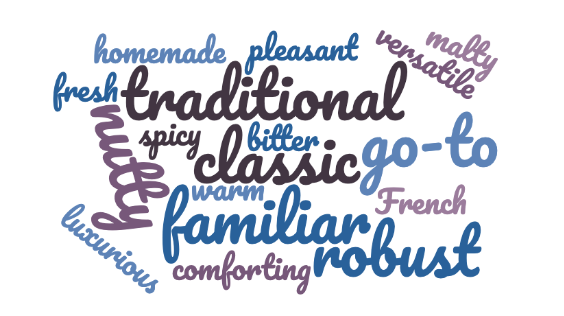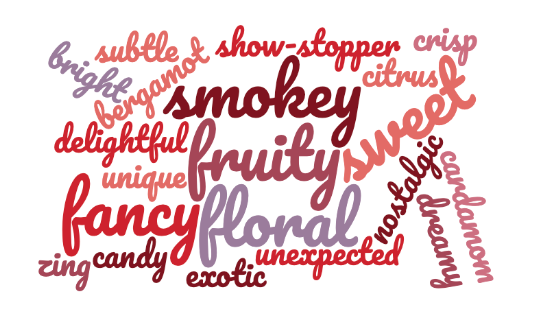Vanilla is a popular flavor around the world, so it's likely that you have it in your pantry. From whole beans to extracts and vanilla-infused sugars, there are many ways to add a touch of this classic flavor to your favorite dishes and baked goodies. Vanilla is categorized based on where the vanilla beans were grown. We carry vanilla products from three regions.
- Madagascar: The most common type with a rich, classic vanilla flavor.
- Mexico: Similar to vanilla from Madagascar, it has a mellow, smooth quality and a spicy, woody fragrance.
- Tahiti: A more delicate flavor with aromatic and floral notes that shine on their own or paired with fruit.
When it comes to vanilla extract, a little splash goes a long way. The extract is all about balancing out flavors and making a well-rounded finished product.
What is Vanilla Extract?
Vanilla extract is made from vanilla beans which actually aren’t beans at all. The “beans” are fruits from the genus Vanilla, a type of orchid, and look like long pods when ready to harvest. A single vanilla bean has about 300 unique flavoring components. However, many of these are delicate flavors that occur in trace amounts and must be carefully extracted to maintain their distinctive flavors. Vanilla beans are soaked in a mixture of water and ethyl alcohol to create the extract.
What is the difference between vanilla extract and pure vanilla extract?
Not all extracts are made the same. In order for a product to be called pure vanilla extract, it must meet standards set by the FDA. Pure vanilla extract must contain at least 35% alcohol and 100g of vanilla beans per liter (13.35 ounces per gallon).
Why is pure vanilla extract so much more expensive?
Buying pure vanilla isn’t always light on the wallet. While it is always worth the money (in our opinion!), it can be an expensive addition to your pantry. So, why is pure vanilla extract so expensive? There is actually a very limited area where vanilla extract can grow. Additionally, pollinating the flowers and harvesting the beans is a very labor intensive process. Because pure vanilla extract requires vanilla beans, that expense is reflected in the price. In fact, vanilla is the world’s second most expensive spice next to saffron. But remember, even though pure vanilla extract can be expensive, many recipes only call for a teaspoon at a time so a little goes a long way.
Social Commitment
We are proud to work with companies that are committed to social responsibility and promoting sustainable farming practices. Our vanilla partners have implemented initiatives to build wells in vanilla farming communities, increasing easy access to clean drinking water.
Where does vanilla extract come from and what is vanilla extract made of?
The edible species of the vanilla orchid are actually native to Central America but today the majority of vanilla comes from Madagascar. About 80% of the world's supply is grown there because it has the perfect climate for vanilla production. Mexico, Tahiti, and other areas in Central America, Africa, and the South Pacific produce the remaining supply of vanilla beans.
Vanilla extract is made by steeping the vanilla bean pods in a mixture of water and ethyl alcohol. Like our other extracts, our Pure Vanilla Extracts maintain their premium flavor whether used in baking, freezing, or other applications.
How is vanilla extract made?
Once the pods cure, they are infused into a mixture that contains water and ethyl alcohol. The mixture draws out the vanilla flavor compounds from the pods, ultimately making the liquid we know as vanilla extract.
High heat extraction methods, used by other companies to quickly mass produce extracts, can destroy the delicate flavor notes, resulting in a weak and somewhat bland taste. To supplement this flavor loss, sugar is often added.
Our vanilla extract is produced using a unique, environmentally friendly Cold Extraction Process to capture the full-bodied richness of the beans. This production process requires smaller batches, which takes more time, but the flavor it produces is much more concentrated and complex.
Many steps go into making a small bottle of vanilla extract. First, the vanilla bean pods have to grow and then cure for 3-4 months. The rich, intense vanilla flavor develops during that time. Then, the beans are chopped using a specially designed machine that does not produce heat. The chopped beans are placed into custom extractors that operate 24 hours a day, 7 days a week. This cold extraction process takes nearly a month to complete but ensures that the deep, rich flavor and delicate sweet, floral notes of each flavor compound are captured in our vanilla extracts.
How to make vanilla extract
While DIY versions of vanilla extract are generally not as intense in flavor as commercially available vanilla, you actually can use a similar process to make your own vanilla extract. Here’s how to do it! But don’t expect this process to happen overnight. Homemade vanilla takes up to 12 months before it is ready.
What Does Vanilla Extract Taste Like?
If you ever tried vanilla extract as a kid, you know that it is a little bit of a trickster when it comes to taste. Out of the bottle, the extract has a heavenly smell. The taste, on the other hand, isn’t necessarily pleasant. Due to the alcohol and water base, it tastes rather bitter until it’s mixed with other ingredients. The final product - after sugar, salt, and fat (like cream, butter, or egg yolks) have been added - is when the extract has the chance to shine.
Madagascar vanilla extract vs. Mexican vanilla extract vs. Tahitian vanilla extract
While vanilla has a very specific growth pattern, it does taste slightly different depending on its origin. Around the world, there are over 150 different varieties of vanilla. We carry three of the most popular: Madagascar, Mexican, and Tahitian vanilla.
Madagascar Vanilla is the most common type of vanilla, accounting for two-thirds of vanilla production around the world. As an all-purpose vanilla, it has a rich, smooth flavor that allows for a great balance in baked goods. We find the taste stands out when baking Fudgy Brownies or Double Vanilla Cupcakes.
Tasters overwhelmingly described Madagascar Vanilla as a familiar and comforting, classic and traditional, and robust. It's the flavor you’d expect from a quality, store-bought vanilla ice cream.
Mexican Vanilla is like Madagascar vanilla taken up a notch. The taste of the vanilla is slightly spicier and has a creamy flavor. It can even be a little smoky with undertones of cinnamon. Because of this, it pairs very well with baked goods that contain warming spices like cinnamon, cloves, and cardamom. We like to use it when baking (like in Espresso & Cocoa Pecan Pie) or in a batch of Horchata.
Both Madagascar and Mexican vanilla are made from the same species of vanilla, Vanilla Planifola. So the main differences in flavor between the two can be attributed to terroir (flavor characteristics imparted by climate, soil, and other environmental factors) and processing methods. Our testers describe the flavor of Mexican vanilla as mellow and smooth, sweet and creamy, with woody, spicy, and cinnamon notes.
Tahitian Vanilla breaks from tradition when it comes to vanilla flavor. This version tends to be more fruity and floral in flavor. The bright notes make it perfect when it's the star of the show or when cooking with fruit. We recommend trying it in our Homemade Marshmallows or Grenadine Infused Cupcakes.
Is Vanilla Extract Healthy?
There are many benefits to incorporating vanilla extract into your everyday diet. Besides making your food taste better, vanilla can actually make you feel better. Vanilla extract is rich in a plant compound called vanillin, which is rich in antioxidants, has anticancer properties, can be anti-inflammatory, and can improve brain health.
Is vanilla extract gluten free?
If you are gluten-free or have celiac disease, you do not need to worry when adding vanilla extract to your diet. The ingredients used to make vanilla extract do not contain any gluten.
Does pure vanilla extract contain alcohol?
Technically speaking, there is alcohol in vanilla extract. However, the alcohol typically burns off during the cooking process. For vanilla extract to be considered pure, the FDA requires there to be at least 35% ethyl alcohol in the product. If you’re looking for an alcohol-free vanilla, try Madagascar Vanilla Bean Paste or just use the beans themselves.
Where and How to Buy Vanilla Extract
Vanilla extract is available in the baking section or most markets and food stores. Keep note of the pure vanilla label to make sure you are getting an authentic product and look out for the words imitation or flavoring.
Our store has a large variety of vanilla extract and other vanilla products. Up your baking game by stocking up on our Madagascar, Mexican, and Tahitian vanilla extracts. Use our store locator to see where you can find our vanilla in a store near you.
Does vanilla extract go bad?
Vanilla extract has an impressive shelf life. As long as the extract is stored properly in a cool and dry place, it will last for about five years. In fact, vanilla extract can develop a stronger flavor over time due to the alcohol evaporating.
Be sure not to put your vanilla extract in the refrigerator or freezer. The cold temperature can actually kill some of the flavor compounds and can turn the extract into a cloudy mixture that isn’t ideal for use.
What Is Vanilla Extract Used For?
Vanilla extract is a staple item when baking. The extract balances out flavors, especially when baking cookies, puddings, cakes, and custards. The extract is also great in drinks like coffee or hot chocolate. A little dash of the extract goes a long way in flavoring.
What Can Be Substituted For Vanilla Extract?
If you find yourself without a drop left of vanilla extract, there is no need to fret. Many everyday pantry items will help replace the extract in a pinch. Vanilla beans are perhaps the closest flavor when it comes to substituting for vanilla extract. Simply slice the beans in half and scrape out the middle. You can save the beans and add them to plain white sugar or your next bottle of vanilla extract to infuse a little extra flavor. Other vanilla products like vanilla bean paste, vanilla bean powder, and vanilla bean sugar will work as great substitutes as well.
If you are out of vanilla products altogether, look to use other extracts like almond or orange, chai spices, fruit zest, honey, or maple syrup. While the flavor won’t be the same, you might be surprised at the new tastes you’ll enjoy. Liquor like brandy, bourbon, or rum will even be a solid replacement. And while we don’t recommend using vanilla vodka in place of extract, due to the fact that it has a much milder vanilla flavor, you can always try it in a pinch.
What Other Spice, Seasoning, and Flavors Pair Well with Vanilla Extract?
The real question here is, what doesn’t vanilla pair well with? Since it is a staple in most baked goods, it has a solid reputation for being a strong pairing when it comes to different spices in both sweet and savory cooking.
Different varieties of vanilla are better suited for various pairings - but there’s no wrong answer here so feel free to mix and match. Madagascar vanilla is best suited for recipes with lots of cardamom and cocoa. Mexican vanilla highlights spice, making it a strong pairing for spices like cloves and cinnamon. Tahitian vanilla falls more fruity on the scale, allowing it to be the perfect saffron companion and for fruit-based desserts and baked goods.
Recipes Using Vanilla Extract
A little splash of vanilla goes a long way with flavor. See for yourself and try out these recipes using our varieties of vanilla extract. While we’ve made some suggestions on which vanilla extract can really shine in these recipes, remember, you can absolutely mix and match. Use your favorite vanilla extract in any recipe, just like in this No-Churn Buttermilk Vanilla Ice Cream.

Madagascar vanilla extract recipes
Madagascar vanilla is the most classic flavor when it comes to vanilla extract. It has a delicate, smooth flavor that is great in pretty much whatever you put it in, as it is super well-rounded.
- Cinnamon Swirl Bundt Cake: Vanilla bean glaze and luscious cinnamon swirls turn this bundt cake into a whole lot of goodness. Vanilla extract, along with Pure Almond Extract, Mayan Sea Salt, and Cinnamon Sugar, make this a standout dessert.
- Iced Cream Coffee: Take your average coffee to the next level by adding a splash of Madagascar vanilla extract. The extract will round out the sweet coffee, making a velvety smooth drink.
- Sweet Potato Souffle: When you are planning your holiday menu, make sure to leave a place for this sweet potato soufflé next to your main course of turkey or ham. The vanilla plus Ground Supreme Saigon Cinnamon and Georgia Peach Spice will make this the favorite side dish of the evening.
- Peach Pie Crumble: Is there a better summertime dessert than peach pie crumble? It’s a mix of pie and crumble in the best way possible. The best part about this dessert is that you can make it when frozen peaches, meaning you can make it year-round.
Mexican vanilla extract recipes
When cooking with spice and zest, leave the classic vanilla extract in the pantry and use Mexican vanilla extract instead. The extract highlights spice is slightly woody in taste and pairs well with other warming spices.
- Espresso Brownie Pie: If you love pecan pie, you will fall in love with this recipe. It is the perfect blend of pecan pie and brownies. It’s nutty, filled with bold chocolate flavors thanks to our Mexican Cocoa, and bold in espresso powder from our Pure Espresso Powder.
- Spiced Apple Butter: You know when you go apple picking and don’t know what to do with all the apples? That’s what this spiced apple butter recipe is for. The Mexican vanilla combined with our Baking Spice and cinnamon makes a spread that you will want to put on just about everything.
- Ghost Pepper Salted Triple Chocolate Cookies: Unleash the heat on your tastebuds with these spicy-sweet chocolate cookies. Our Ghost Pepper Salt adds a bold burst of spice that pairs excellently with a chocolate cookie base. Just make sure to have a glass of milk nearby!
- Horchata: Bold flavors from the Mexican vanilla, Ground Ceylon "True" Cinnamon, and Mayan Sea Salt make this horchata truly delightful. It’s bold in spice in the best way possible.
Tahitian vanilla extract recipes
A little Tahitian vanilla is excellent when cooking with sweet, fruity flavors. The fruity notes and strong aromas make it an excellent addition to any sweets, especially those fruity and floral-based recipes.
- Grenadine Infused Cream Cheese Frosting: Shirley Temple lovers will have a hard time eating just one of these cupcakes. The Grenadine Infused Cream Cheese Frosting can be used on any cupcake, but taste even better when made alongside our Grenadine-Infused Cupcakes.
- Saffron Salted Almond Brittle: Give your typical almond brittle a little bit of a makeover using this recipe. Saffron Salt combined with Tahitian vanilla adds a floral flavor that sits on the tongue perfectly.
- Pumpkin Cheesecake Bars: Ditch the pumpkin pie this fall and make these pumpkin cheesecake bars instead. All the warm flavors of fall come teeming through each bite thanks to the Pumpkin Pie Spice.
- Brown Butter Chocolate Chip Cookies: You’ll never need another chocolate chip cookie recipe again after you make these brown butter chocolate chip cookies. They are slightly fruity, bold in chocolate flavor for the Pure Espresso Powder, and have a salty finish thanks to a light sprinkle of French Fleur de Sel Sea Salt.
Browse all Extracts and Baking Spices. Tell us about your favorite vanilla recipes below or tag us on Instagram @savoryspiceshop






